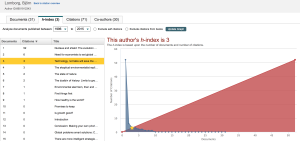 There’s been quite a bit of palaver recently about the invasion of Lomborg’s ‘Consensus’ Centre to the University of Western Australia, including inter alia that there was no competitive process for the award of $4 million of taxpayer money from the Commonwealth Government, that Lomborg is a charlatan with a not-terribly-well-hidden anti-climate change agenda, and that he his not an academic and possesses no credibility, so he should have no right to be given an academic appointment at one of Australia’s leading research universities.
There’s been quite a bit of palaver recently about the invasion of Lomborg’s ‘Consensus’ Centre to the University of Western Australia, including inter alia that there was no competitive process for the award of $4 million of taxpayer money from the Commonwealth Government, that Lomborg is a charlatan with a not-terribly-well-hidden anti-climate change agenda, and that he his not an academic and possesses no credibility, so he should have no right to be given an academic appointment at one of Australia’s leading research universities.
On that last point, there’s been much confusion among non-academics about what it means to have no credible academic track record. In my previous post, I reproduced a letter from the Head of UWA’s School of Animal Biology, Professor Sarah Dunlop where she stated that Lomborg had a laughably low h-index of only 3. The Australian, in all their brilliant capacity to report the unvarnished truth, claimed that a certain Professor Ian Hall of Griffith University had instead determined that Lomborg’s h-index was 21 based on Harzing’s Publish or Perish software tool. As I show below, if Professor Hall did indeed conclude this, it shows he knows next to nothing about citation indices.
What is a ‘h-index’ and why does it matter? Below I provide an explainer as well as some rigorous analysis of Lomborg’s track record.
The h-index stands for the Hirsch index, created by Jorge Hirsch of the University of California, San Diego ten years ago. Put simply, it’s the number of academic (peer-reviewed) papers h one has published with citation number ≥ h. As an example, let’s say I have published ten peer-reviewed journal articles (‘papers’) in my life to date. In descending order, they have been cited by different authors (of other peer-reviewed journal articles) 256, 150, 10, 4, 3, 3, 3, 2, 1, 0 times. Even though I have a total of 432 citations from those 10 papers, giving a mean of 43.2 citations per paper, this is driven largely by only 2 papers. As such, my h-index would be 4 (I have 4 papers with at least 4 citations). For me to increase my h-index to 5, I would need at least one more citation for the paper currently sitting at 4 citations, and at least 2 more citations from one of my other papers that currently only have 3 or fewer citations.
You can see the advantages of using such an index – it’s not influenced to the same degree by wild outliers and it resists artificial inflation by auto-citation (citing your previous papers in your latest ones). The disadvantage of the h-index is that even if you die, it can still increase as time progresses, such that the older you get, the higher your h-index. Some have proposed correcting for this by dividing the h-index by the number of years since your first publication (called the ‘m-index’). This essentially indicates your ‘speed’ of accumulating citations. As a general rule, if your m-index is over 1, you’re an active, publishing researcher. If your m-index is greater than 2, you’re doing very well.
But what can you count as a ‘paper’? This is in fact the crux of the bullshit floating around the web on this particular issue with respect to Lomborg. As a general rule, the two main services to calculate the h-index – Scopus (Elsevier) and Web of Science (Thomson Reuters) – are perhaps a little conservative (i.e., they don’t necessarily count all your works or all the citations to them). This is because they have very stringent rules for what counts as a ‘paper’ – they have to be recognised and accredited, peer-reviewed academic journals (i.e., books, magazine and newspaper articles are disallowed), and in the case of Web of Science, have to be ISI-indexed journals.

Lomborg only has a Scopus profile (you need a subscription to see this), which gives an h-index = 3 based on 31 articles and a total of 71 citations (see adjacent screenshot). He hasn’t set up a public ResearcherID, which would give his Web of Science h-index, but I took the liberty of combing through all of his Web of Science-listed articles and came up with the exact same h-index (3), based on 25 articles and 54 total citations.
Google Scholar is the new kid on the block to calculate researcher citation profiles, but to use this, each individual researcher needs to set up a Google Scholar profile (you can see mine here). Every academic should do this because it’s free to use and browse. If one doesn’t do this (and Lomborg hasn’t), then you have to search for individual publications on Google Scholar.
Herein lies the problem for those who submit that Lomborg’s h-index is 21. Software tools like Harzing’s Publish or Perish are merely Google Scholar aggregators; in other words, they merely act as a front end for the Google Scholar search engine. They are not individual profiles. In fact, ever since Google Scholar introduced profiles a few years ago, Publish or Perish has become entirely obsolete. Why? Because it aggregates everything – including all the inappropriate stuff – and vastly overestimates one’s h-index. Further, it doesn’t distinguish duplicates entries, makes no differentiation between peer-reviewed or non-peer-reviewed articles, and it counts any mention of the author’s name, even if isn’t one of their own articles! In other words, it’s utterly flawed.
So, in the absence of a Google Scholar profile for Lomborg, I combed through his Google Scholar entries and dumped all the duplicates, I ignored all the magazine and newspaper articles (e.g., you can’t count opinion editorials in The Wall Street Journal as evidence of an academic track record), I cut out all non-articles (things Lomborg hadn’t actually written), omitted any website diatribes (e.g., blog posts and the like) and calculated his citation profile.
Based on my analysis, Lomborg’s Google Scholar h-index is 4 for his peer-reviewed articles. If I was being particularly generous and included all of Lomborg’s books, which have by far the most citations, then his h-index climbs to 9. However, none of his books is peer-reviewed, and in the case of his most infamous book, The Skeptical Environmentalist, it has been entirely discredited. As such, any reasonable academic selection committee would omit any metrics based on opinion-based books.
So, the best-case scenario is that Lomborg’s h-index is no more than 4. Given his appointment to Level D (Associate Professor) at a world-class university, the suggestion that he earned it on academic merit is not only laughable, it’s completely fraudulent. There is no way that his academic credentials had anything to do with the appointment.
CJA Bradshaw

